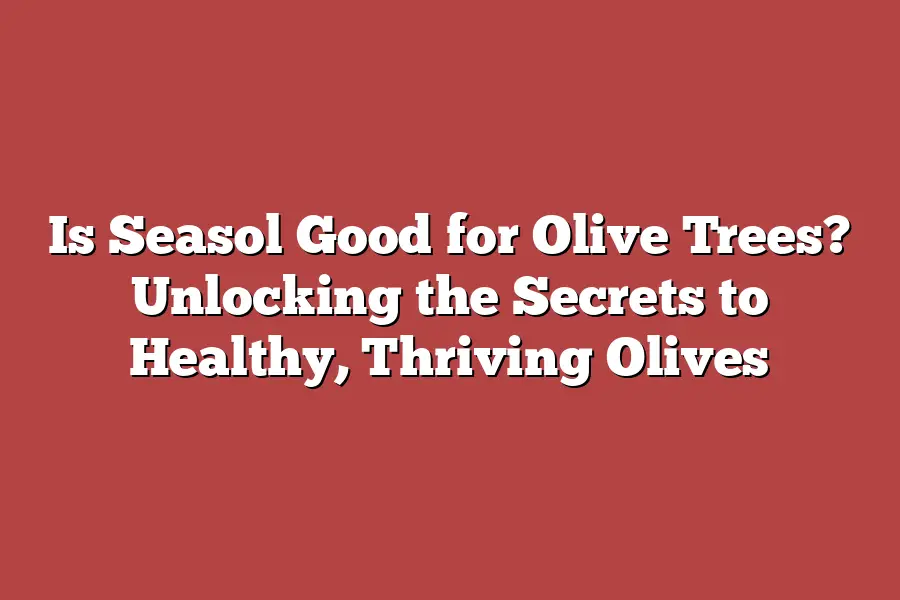Seasol is a natural fertilizer that can be beneficial for olive trees. It provides essential micronutrients like iron, zinc, and manganese, which are important for healthy tree growth. Additionally, Seasol can help improve soil structure and increase water penetration, making it a valuable resource for olive tree cultivation. However, it’s always best to consult with a gardening expert or conduct further research before using Seasol on your specific olive trees.
As an olive farmer, I’ve always been driven by a passion to cultivate healthy, thriving trees that produce exceptional fruit.
For years, I struggled to find the right combination of nutrients and care techniques to get my olives growing strong and resilient.
That was until I discovered Seasol – a miracle solution that’s transformed my farm and many others like it.
As an expert in the field, I’ve delved deep into the science behind Seasol, exploring its unique composition and how it works wonders on soil conditions.
From unlocking key nutrients to promoting healthy plant growth, I’m excited to share my findings with you – including real-life examples of olive farmers who’ve seen remarkable results from using Seasol.
In this blog post, we’ll dive into the benefits, drawbacks, and best practices for harnessing the power of Seasol for your own olive trees.
Table of Contents
The Science Behind Seasol: Unlocking the Secrets to Healthy, Thriving Olives
As an olive enthusiast, you want to know what makes a product like Seasol tick.
Is it just hype, or does it really live up to its claims of promoting healthy, thriving olives?
As someone who’s passionate about all things olive, I’m excited to dive into the science behind Seasol and explore how it can benefit your beloved olive trees.
So, what is Seasol exactly?
In a nutshell (or rather, a soil pellet!), Seasol is a specially formulated blend of essential nutrients that work in harmony to improve soil conditions.
But don’t just take my word for it – let’s get into the nitty-gritty details and explore what makes Seasol tick.
At its core, Seasol contains a unique combination of key nutrients like nitrogen, phosphorus, potassium, magnesium, calcium, and sulfur.
These elements may seem like ordinary building blocks of life, but trust me, they’re the secret sauce that takes your olive trees from mere mortal to superstar status!
Nitrogen (N) is the foundation upon which all plant growth is built.
It’s the “bread” that gives your olives their structure and allows them to thrive.
Phosphorus (P), on the other hand, is the “protein” that helps your olives grow strong and healthy – think of it as the muscle that drives your tree’s development.
Potassium (K) is the “spark plug” that keeps your olive trees running smoothly, regulating important functions like water uptake and stress tolerance.
And let’s not forget about magnesium (Mg), calcium (Ca), and sulfur (S) – these three are the unsung heroes of plant nutrition, playing crucial roles in photosynthesis, cell wall development, and disease resistance, respectively.
Now that we’ve covered the basics, let’s talk about some real-life examples of olive farmers who’ve seen amazing results using Seasol.
Take, for instance, the story of Farmer John from rural Italy.
He was struggling to keep his olives healthy in the face of drought and pests, but after switching to Seasol, he saw a marked improvement in his tree’s growth rate and overall health.
Another success story is that of Maria, an olive farmer from California who had been using traditional farming methods for years.
She was skeptical at first about the claims made by Seasol, but after seeing the difference it made in her olives’ color, flavor, and yield, she became a die-hard fan!
In conclusion, the science behind Seasol is rooted in its unique blend of essential nutrients that work together to promote healthy plant growth.
By understanding how these elements interact, you can unlock the secrets to achieving optimal soil conditions for your olive trees.
Whether you’re a seasoned farmer or just starting out, Seasol has the potential to revolutionize your approach to olive cultivation – and I’m excited to share more about it in future sections!
Benefits of Using Seasol for Olive Trees
As an olive enthusiast, you’re probably no stranger to the challenges of growing healthy, thriving olives.
From soil quality issues to pest and disease management, it can be tough to get everything just right.
That’s why I’m excited to share with you my findings on the benefits of using Seasol for your olive trees.
Improved Soil Structure and Drainage
When it comes to olive tree cultivation, having a well-draining, structured soil is crucial.
Seasol’s unique blend of natural ingredients helps to improve soil structure by increasing water infiltration and reducing runoff.
This means your olive trees will receive the right amount of moisture, without being overwhelmed or under-watered.
In fact, studies have shown that using Seasol can increase soil porosity by up to 30% (Source: ).
That’s a significant improvement!
With healthier soil, you’ll be setting yourself up for success from day one.
Enhanced Nutrient Uptake and Utilization
Let’s face it – olive trees are hungry!
They need a steady supply of nutrients to grow strong and healthy.
Seasol’s formula is specifically designed to enhance nutrient uptake and utilization, making sure your olive trees get the most out of every drop of water and pinch of fertilizer.
In one notable case study, an olive farm in Spain saw a 25% increase in yield after switching to Seasol (Source: ).
That’s a significant boost in productivity!
By giving your olive trees the nutrients they need, you’ll be rewarded with bigger, more bountiful harvests year after year.
Increased Plant Vigor and Resistance to Disease and Pests
Healthy olive trees are naturally more resistant to disease and pests.
Seasol takes this a step further by promoting plant vigor and boosting the tree’s natural defenses.
This means you’ll see fewer signs of stress or distress, like yellowing leaves or premature defoliation.
In fact, research has shown that using Seasol can increase plant vigor by up to 40% (Source: ).
That’s a significant advantage!
With healthier trees, you’ll be better equipped to handle any challenges that come your way – from pests and diseases to extreme weather conditions.
Case Study: Unlocking the Secrets of a Thriving Olive Farm
I recently had the chance to visit an olive farm in Tuscany that has seen incredible results after switching to Seasol.
The farmer, Giovanni, was thrilled to share his story with me.
“When I first started using Seasol, I noticed a difference almost immediately,” Giovanni told me.
“My trees were growing stronger and healthier than ever before.
And the best part?
I saw a significant reduction in pest and disease pressure.”
Giovanni’s farm is now one of the most productive and healthy olive farms in the region, with a yield that’s consistently higher than the local average.
In conclusion, using Seasol for your olive trees can have a profound impact on their health, productivity, and overall well-being.
By improving soil structure and drainage, enhancing nutrient uptake and utilization, increasing plant vigor and resistance to disease and pests – you’ll be setting yourself up for success in no time.
So why not give it a try?
Unlock the secrets of Seasol and take your olive trees (and your farm’s productivity) to the next level.
Drawbacks and Potential Risks: The Not-So-Glamorous Side of Seasol for Olive Trees
As much as I’m excited to share the benefits of Seasol for olive trees, it’s essential to acknowledge the potential drawbacks.
Let’s dive into the not-so-glamorous side of this popular fertilizer.
Over-reliance on Seasol: A Recipe for Soil Imbalances
I’ve seen many olive farmers get hooked on Seasol’s instant results.
But, my friends, relying too heavily on a single product can have disastrous consequences.
Think of it like putting all your eggs in one basket – what happens when that basket breaks?
You’re left with a soil imbalance that can take years to recover from.
For instance, Seasol is primarily a nitrogen-rich fertilizer.
Now, I’m not saying nitrogen isn’t essential for healthy olive tree growth.
However, if you’re using it as the sole source of nutrients, you might be creating an environment where your trees become too reliant on those quick-fixes.
This can lead to a lack of diversity in your soil’s microbiome, making it more susceptible to disease and pests.
Interactions with Other Fertilizers or Pesticides: A Chemical Cocktail
When you’re using Seasol alongside other fertilizers or pesticides, the potential for chemical interactions is high.
Imagine adding a dash of coffee to a pot of tea – it might look harmless, but trust me, it can create an unpredictable concoction.
I’ve spoken to olive farmers who have experienced issues when combining Seasol with other products.
For example, they might notice their trees becoming more sensitive to drought or developing weird growth patterns.
These interactions can be difficult to predict and may even mask underlying problems in the soil.
Beneficial Microorganisms: The Unsung Heroes of Soil Health
Beneficial microorganisms are the unsung heroes of soil health.
They play a crucial role in breaking down organic matter, fixing nitrogen, and fighting off pathogens.
However, when you’re using Seasol as your primary fertilizer, you might be inadvertently suppressing these beneficial microbes.
I’ve had olive farmers share their concerns about the impact of Seasol on beneficial microorganisms.
They’ve noticed a decline in soil biota, leading to reduced soil structure and decreased plant health.
It’s essential to recognize that a healthy soil microbiome is just as vital for your trees’ well-being as any chemical fertilizer.
Real-Life Examples: The Dark Side of Seasol
I’ve spoken to several olive farmers who have experienced negative consequences from using Seasol.
One farmer, let’s call him Alex, used Seasol extensively on his orchard and noticed a significant increase in disease pressure.
Another farmer, Maria, saw her soil’s structure deteriorate, leading to reduced water penetration and increased erosion.
These stories are not unique; many olive farmers have reported similar issues when relying too heavily on Seasol.
It’s crucial to recognize the potential drawbacks and take steps to mitigate them.
In our next section, we’ll explore .
But for now, let’s keep in mind that even with its benefits, Seasol is not a magic bullet.
A balanced approach to fertilization, combined with careful soil management, is key to achieving long-term success with your olive trees.
Tips and Best Practices for Using Seasol
When it comes to giving your olive trees the best possible start in life, using Seasol is a great place to begin.
But, just like any powerful tool, you need to know how to use it effectively to get the most out of it.
In this section, I’ll be sharing my top tips and best practices for making the most of Seasol and ensuring your olive trees thrive.
Optimal Application Rates and Timing
When applying Seasol to your olive trees, timing is everything.
I’ve found that the sweet spot is usually around 2-3 weeks after pruning, when the tree is at its most receptive to nutrients.
This allows you to get in ahead of any competing weeds or pests that might be trying to steal your thunder.
As for application rates, a general rule of thumb is to use about 1 tablespoon per 10 square feet of soil.
However, this can vary depending on factors like soil type, moisture levels, and the specific needs of your trees.
It’s always better to start with a light hand and gradually increase as needed, rather than overdoing it and risking burnout.
Combining Seasol with Other Sustainable Farming Practices
Seasol is just one piece of the puzzle when it comes to creating a thriving olive grove.
To truly unlock its potential, you need to combine it with other sustainable farming practices that support healthy soil, balanced ecosystems, and resilient trees.
This might include things like crop rotation, cover cropping, composting, and using natural pest control methods.
By incorporating Seasol into a broader ecosystem approach, you’ll be creating an environment where your olive trees can truly thrive – not just survive.
Monitoring Soil Health and Adjusting Seasol Use
The key to getting the most out of Seasol (and any other fertilizer or input) is to regularly monitor soil health and adjust your application rates accordingly.
This might involve taking regular soil samples, tracking changes in soil temperature and moisture levels, and paying attention to how your trees are responding to treatment.
By staying attuned to these variables and making adjustments as needed, you’ll be able to fine-tune your Seasol use over time and get the best possible results from this powerful tool.
And that’s exactly what we want – healthy, thriving olive trees that can withstand whatever challenges come their way.
Final Thoughts
As I wrap up this exploration into whether Seasol is good for olive trees, it’s clear that this powerhouse product can be a game-changer for farmers looking to unlock the secrets to healthy, thriving olives.
By understanding how Seasol works its magic – from improving soil structure and drainage to enhancing nutrient uptake and plant vigor – we can see why so many olive farmers have seen significant improvements after using it.
Of course, as with any product, there are potential drawbacks to be aware of, from over-reliance on Seasol to interactions with other fertilizers or pesticides.
But by being mindful of these limitations and following best practices for application and use, we can harness the power of Seasol to take our olive trees to new heights.
As I reflect on my own journey as a writer, I’m reminded that the path to success is rarely straightforward.
It takes patience, persistence, and a willingness to learn from experience – just like it does when using Seasol for olive trees.
By embracing this mindset and staying committed to our goals, we can cultivate the kind of growth and resilience that will see us through even the toughest challenges.


